Aperçu des plaquettes en carbure Tracker
Lorsqu'il s'agit d'usinage et de fabrication de précision, les plaquettes en carbure de tungstène jouent un rôle essentiel. Ces composants minuscules, mais incroyablement robustes, sont essentiels dans de nombreuses applications industrielles, de l'automobile à l'aérospatiale, grâce à leur durabilité et à leur efficacité. Mais qu'est-ce qui rend ces plaquettes si spéciales ? Plongeons dans le monde des plaquettes en carbure de tungstène, en explorant leurs types, leurs applications, les propriétés des matériaux et bien d'autres choses encore.
Types de Plaquettes en carbure Tracker
Il est essentiel de comprendre les différents types de plaquettes en carbure pour chenilles afin de choisir celle qui convient le mieux à vos besoins spécifiques. Voici une présentation détaillée :
| Type d'insertion | Description |
|---|---|
| Carbure cémenté | Mélange de carbure de tungstène et d'un métal liant, généralement du cobalt, offrant une excellente dureté. |
| Cermet | Combine des matériaux céramiques et métalliques pour une résistance à l'usure et une ténacité élevées. |
| Carbure revêtu | Comporte une fine couche de carbure de titane ou d'oxyde d'aluminium pour améliorer les performances de coupe. |
| Céramique | Fabriqués en alumine ou en nitrure de silicium, ils conviennent à l'usinage à grande vitesse et aux matériaux durs. |
| CBN (nitrure de bore cubique) | Idéal pour couper les aciers trempés et les superalliages, offrant une résistance supérieure à l'usure. |
| Diamant | Meilleur pour les matériaux non ferreux tels que l'aluminium et le cuivre, offrant une dureté inégalée. |
| Revêtement PVD | Revêtement par dépôt physique en phase vapeur pour une meilleure stabilité thermique et chimique. |
| Carbure non revêtu | Carbure de tungstène lisse, excellent pour les métaux non ferreux et la fonte. |
| Nitrure de silicium | Parfait pour les applications lourdes nécessitant une grande robustesse. |
| Revêtement TiCN | Revêtement en carbonitrure de titane pour une meilleure ténacité et résistance à l'usure. |
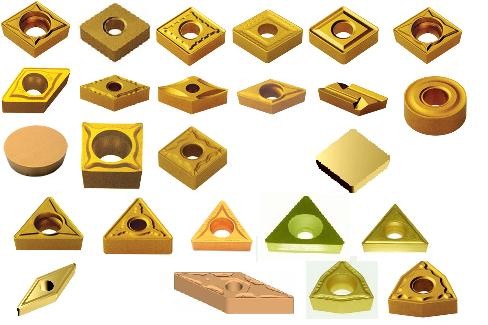
Applications des plaquettes en carbure Tracker
La polyvalence des plaquettes en carbure de tungstène les rend indispensables dans diverses industries. Voici comment elles sont utilisées dans différents domaines :
| L'industrie | Application |
|---|---|
| Automobile | Fabrication de composants de moteurs et de transmissions. |
| Aérospatiale | Usinage d'alliages à haute résistance utilisés dans les structures aéronautiques. |
| Médical | Production d'instruments et d'implants médicaux de précision. |
| Pétrole et gaz | Fabrication d'équipements de forage et d'exploration. |
| Électronique | Usinage de précision de composants et de dispositifs électroniques. |
| La construction | Outils et composants de machines nécessitant une grande durabilité. |
| Travail des métaux | Usinage général et finition de pièces métalliques. |
| Moules et matrices | Fabrication de moules et de matrices pour divers procédés de fabrication. |
| Exploitation minière | Outils de coupe et de forage utilisés dans les opérations minières. |
| Marine | Composants pour navires et structures offshore. |
Propriétés matérielles des Plaquettes en carbure Tracker
Comprendre les propriétés des matériaux des plaquettes en carbure de tungstène est essentiel pour sélectionner la plaquette adaptée à votre application :
| Propriété | Description |
|---|---|
| Dureté | Mesure la résistance à la déformation et à l'usure. |
| Solidité | Capacité à absorber l'énergie et à résister à la fracturation. |
| Résistance à l'usure | Résistance à l'usure abrasive et à l'érosion. |
| Stabilité thermique | Capacité à conserver ses propriétés à des températures élevées. |
| Résistance chimique | Résistance à la corrosion et aux attaques chimiques. |
| Conductivité thermique | Capacité à éloigner la chaleur de l'arête de coupe. |
| Résistance à la rupture | Résistance à la propagation des fissures. |
| Densité | Masse par unité de volume, influençant la résistance et la stabilité de l'insert. |
| Module d'élasticité | Mesure de la rigidité du matériau. |
| Dilatation thermique | Vitesse à laquelle le matériau se dilate lorsqu'il est chauffé. |
Composition et caractéristiques
Voici un aperçu de la composition, des propriétés et des caractéristiques des différents types de plaquettes en carbure de tungstène :
| Type | Composition | Propriétés | Caractéristiques |
|---|---|---|---|
| Carbure cémenté | WC-Co (carbure de tungstène-cobalt) | Dureté et ténacité élevées | Excellent pour l'usinage général |
| Cermet | TiC + Ni/Co (carbure de titane + nickel/cobalt) | Haute résistance à l'usure | Idéal pour les applications de finition |
| Carbure revêtu | TiC/Al2O3 (carbure de titane/alumine) | Performances de coupe accrues | Adapté à l'usinage à grande vitesse |
| Céramique | Al2O3/Si3N4 (alumine/nitrure de silicium) | Résistance aux hautes températures | Meilleur pour les matériaux durs |
| CBN | Nitrure de bore cubique | Résistance supérieure à l'usure | Parfait pour les aciers trempés |
| Diamant | Diamant pur | Dureté inégalée | Excellent pour les matériaux non ferreux |
| Revêtement PVD | Divers nitrures ou carbures métalliques | Stabilité thermique et chimique améliorée | Adapté aux conditions exigeantes |
| Carbure non revêtu | Carbure de tungstène pur | Excellente résistance | Idéal pour les métaux non ferreux |
| Nitrure de silicium | Nitrure de silicium | Haute ténacité | Idéal pour les applications lourdes |
| Revêtement TiCN | Carbonitrure de titane | Ténacité et résistance à l'usure accrues | Polyvalent pour diverses applications |
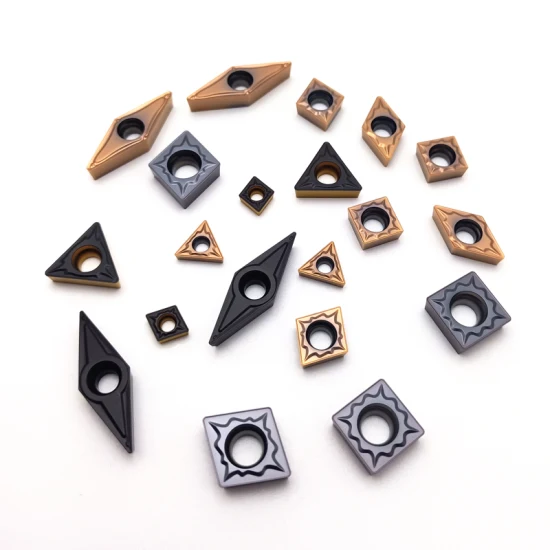
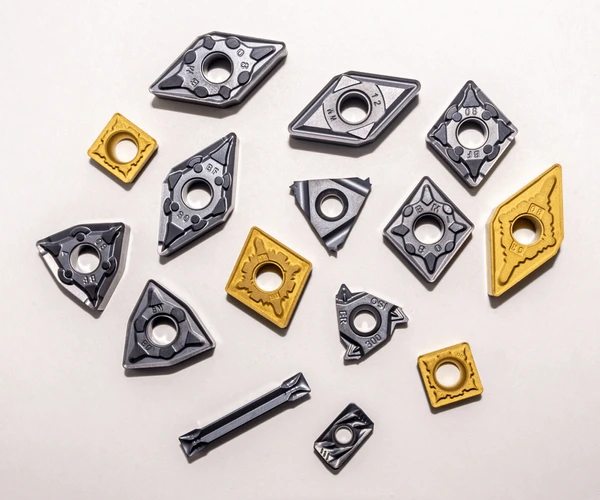
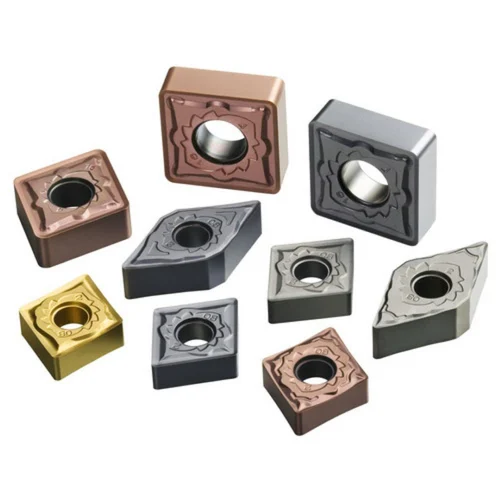

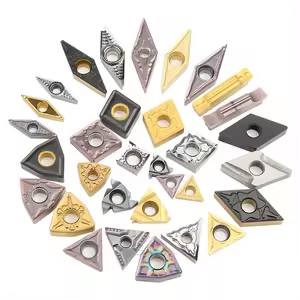
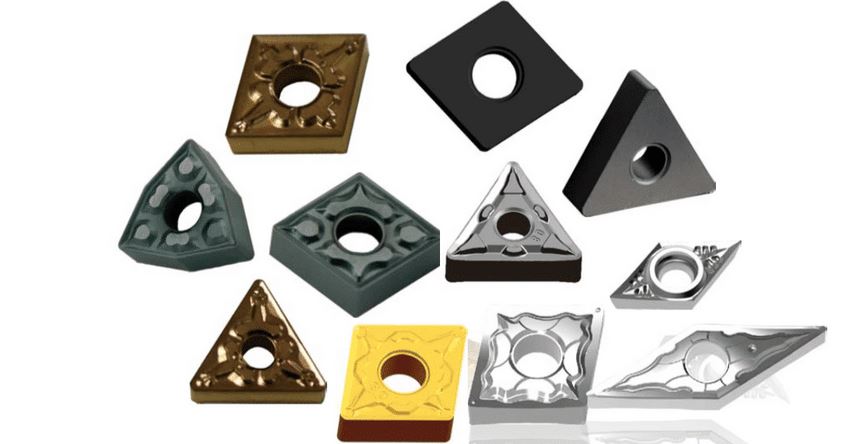
Dureté, solidité et résistance à l'usure
La dureté, la solidité et la résistance à l'usure des plaquettes en carbure de tungstène déterminent leur adéquation à différentes applications :
| Type d'insertion | Dureté (HV) | Résistance (MPa) | Résistance à l'usure |
|---|---|---|---|
| Carbure cémenté | 1500-2000 | 2000-3000 | Haut |
| Cermet | 1700-2200 | 2200-3200 | Très élevé |
| Carbure revêtu | 1800-2300 | 2300-3300 | Extrêmement élevé |
| Céramique | 2000-2500 | 2500-3500 | Haut |
| CBN | 3000-4000 | 3500-4500 | Extrêmement élevé |
| Diamant | 5000-7000 | 4000-5000 | Inégalé |
| Revêtement PVD | 2200-2700 | 2700-3700 | Très élevé |
| Carbure non revêtu | 1600-2100 | 2100-3100 | Haut |
| Nitrure de silicium | 1800-2300 | 2800-3800 | Très élevé |
| Revêtement TiCN | 1900-2400 | 2400-3400 | Haut |
Spécifications, tailles, formes, normes
Le choix de la plaquette en carbure de tungstène appropriée implique de tenir compte de ses spécifications, de ses dimensions, de ses formes et de sa conformité aux normes industrielles :
| Spécifications | Détails |
|---|---|
| Normes ISO | ISO 513, ISO 1832, etc. |
| Insérer des formes | Carré, triangle, rond, diamant, hexagone, etc. |
| Tailles | Divers, généralement désignés par une combinaison de lettres et de chiffres indiquant les dimensions. |
| Épaisseur du revêtement | 1-10 micromètres en fonction de l'application. |
| Préparation des bords | Bords tranchants, adoucis, chanfreinés ou arrondis pour répondre aux différentes exigences de coupe. |
| Classe de tolérance | H7, H8, etc., indiquant l'écart admissible dans les dimensions. |
| Compatibilité | Conçus pour s'adapter à des porte-outils et des machines spécifiques, souvent indiqués par le fabricant. |
| Méthodes de refroidissement | Refroidissement sec, humide ou cryogénique en fonction du matériau et du processus d'usinage. |
| Normes spécifiques aux applications | Normes ASTM, ANSI, DIN applicables à des applications industrielles spécifiques. |
Fournisseurs et détails des prix
Trouver le bon fournisseur pour plaquettes en carbure de tungstène est essentielle pour garantir la qualité et la fiabilité :
| Fournisseur | Pays | Gamme de produits | Prix (USD) |
|---|---|---|---|
| Sandvik Coromant | Suède | Gamme complète de plaquettes en carbure | $10 - $150 par insert |
| Kennametal | ÉTATS-UNIS | Grande variété de plaquettes en carbure et de plaquettes revêtues | $15 - $200 par insert |
| Matériaux Mitsubishi | Japon | Outils de coupe à haute performance | $12 - $180 par insert |
| Outils Seco | Suède | Gamme complète d'inserts | $14 - $160 par insert |
| Iscar | Israël | Solutions innovantes en carbure | $13 - $175 par insert |
| Walter AG | Allemagne | Outils de précision de haute qualité | $11 - $155 par insert |
| Sumitomo Electric | Japon | Plaquettes avancées en carbure et CBN | $16 - $190 par insert |
| TaeguTec | Corée du Sud | Des solutions rentables en carbure | $9 - $140 par insert |
| Kyocera | Japon | Diverses gammes de plaquettes en céramique et en carbure | $10 - $150 par insert |
| Tungaloy | Japon | Outils spécialisés en carbure et en céramique | $14 - $170 par insert |
Sélection des plaquettes en carbure Tracker appropriées
Le choix de la bonne plaquette en carbure de tungstène implique plusieurs considérations. Voici un guide qui vous aidera à prendre une décision éclairée :
| Considération | Détails |
|---|---|
| Matériau | Adaptez le matériau de la plaquette à celui de la pièce à usiner pour une performance optimale. |
| Revêtement | Choisissez des plaquettes revêtues pour une meilleure résistance à l'usure et une plus longue durée de vie de l'outil. |
| Forme de l'insert | Sélectionnez la forme en fonction du type de coupe et de la compatibilité avec la machine. |
| Vitesse de coupe | Les vitesses plus élevées nécessitent des plaquettes ayant une meilleure stabilité thermique. |
| Vitesse d'alimentation | Réglez la vitesse d'avance en fonction des capacités de la plaquette et du matériau usiné. |
| Profondeur de coupe | S'assurer que la plaquette peut traiter la profondeur requise sans compromettre la durée de vie de l'outil. |
| Compatibilité des machines | Vérifiez que la plaquette est compatible avec votre équipement d'usinage. |
| Application | Tenez compte de l'application spécifique, telle que l'ébauche ou la finition, pour sélectionner la plaquette appropriée. |
| Coût | Comparez le coût de l'insert aux performances et à la durée de vie prévues. |
| Réputation du fournisseur | Choisissez des fournisseurs réputés pour leur qualité et leur régularité. |
Comparaison des avantages et des limites
Différents types de plaquettes en carbure de tungstène offrent des avantages et des limites différents. Voici une comparaison pour vous aider à choisir la meilleure option :
| Type d'insertion | Avantages | Limites |
|---|---|---|
| Carbure cémenté | Dureté et résistance élevées, polyvalent. | Peut être fragile en cas d'impact important. |
| Cermet | Excellente résistance à l'usure et excellent état de surface. | Ténacité limitée par rapport au carbure cémenté. |
| Carbure revêtu | Amélioration des performances de coupe et de la durée de vie de l'outil. | Coût plus élevé en raison du revêtement. |
| Céramique | Performance supérieure à haute température, idéale pour les matériaux durs. | Fragile et peut se fracturer sous une forte charge. |
| CBN | Idéal pour les matériaux durs et superalliés, extrêmement résistant à l'usure. | Coûteux et ne convient pas aux matériaux souples. |
| Diamant | Dureté inégalée, excellente pour les matériaux non ferreux. | Très coûteux et inadapté aux matériaux ferreux. |
| Revêtement PVD | Stabilité thermique et chimique améliorée, polyvalent. | Peut être plus coûteux en raison des procédés de revêtement avancés. |
| Carbure non revêtu | Rentables et excellents pour des applications spécifiques. | Résistance à l'usure limitée par rapport aux plaquettes revêtues. |
| Nitrure de silicium | Très résistant, parfait pour les applications lourdes. | Ils peuvent être plus coûteux et plus difficiles à obtenir. |
| Revêtement TiCN | Ténacité et résistance à l'usure accrues, polyvalent pour diverses applications. | Coût plus élevé par rapport aux plaquettes en carbure non revêtues ou de base. |

FAQ
Qu'est-ce qu'une plaquette en carbure de tungstène ?
Les plaquettes en carbure de tungstène sont des outils de coupe composés de carbure de tungstène et de cobalt, utilisés dans diverses applications d'usinage pour leur durabilité et leur efficacité.
Comment choisir la bonne plaquette en carbure de tungstène ?
Prenez en compte des facteurs tels que le matériau de la pièce, la vitesse de coupe, la vitesse d'avance, la profondeur de coupe et la compatibilité de la machine. Consultez également des fournisseurs réputés et choisissez en fonction des besoins spécifiques de votre application.
Quels sont les avantages des plaquettes en carbure revêtues ?
Les plaquettes en carbure revêtues offrent une meilleure résistance à l'usure, une plus longue durée de vie de l'outil et de meilleures performances de coupe, en particulier à des vitesses élevées et dans des conditions exigeantes.
Puis-je utiliser des plaquettes diamantées pour l'usinage de l'acier ?
Non, les plaquettes diamantées ne conviennent pas aux matériaux ferreux comme l'acier en raison des réactions chimiques qui peuvent dégrader le diamant. Elles conviennent mieux aux matériaux non ferreux.
Quelle est la différence entre les revêtements PVD et CVD ?
Les revêtements PVD (Physical Vapor Deposition) offrent une meilleure adhérence et sont idéaux pour les arêtes de coupe plus vives, tandis que les revêtements CVD (Chemical Vapor Deposition) sont plus épais et offrent une plus grande résistance à l'usure.
Pourquoi les plaquettes CBN sont-elles si chères ?
Les plaquettes CBN (nitrure de bore cubique) sont coûteuses en raison de leur résistance supérieure à l'usure et de leur capacité à usiner des matériaux durs et superalliés, offrant des avantages significatifs en termes de performances dans des applications spécifiques.
À quelle fréquence dois-je remplacer mes plaquettes en carbure Tracker ?
La fréquence de remplacement dépend de l'application, du matériau usiné et du type spécifique de plaquette utilisé. Surveillez les signes d'usure et remplacez-les si nécessaire pour maintenir des performances optimales.
Les plaquettes en carbure non revêtues sont-elles encore utiles ?
Oui, les plaquettes en carbure non revêtues sont rentables et donnent de bons résultats dans des applications spécifiques, notamment pour l'usinage des métaux non ferreux et de la fonte.
Quels sont les meilleurs fournisseurs de plaquettes en carbure de tungstène ?
Parmi les fournisseurs réputés figurent Sandvik Coromant, Kennametal, Mitsubishi Materials, Seco Tools, Iscar, Walter AG, Sumitomo Electric, TaeguTec, Kyocera et Tungaloy.
Comment puis-je prolonger la durée de vie de mes plaquettes en carbure ?
Utilisez les bons paramètres de coupe, assurez un bon refroidissement, évitez les vitesses de coupe et les vitesses d'avance excessives et sélectionnez la plaquette appropriée au matériau et à l'application.
Conclusion
Le choix de la bonne plaquette en carbure de tungstène est essentiel pour obtenir des performances optimales dans les applications d'usinage. En comprenant les types, les propriétés des matériaux, les applications et la manière de sélectionner la plaquette la mieux adaptée à vos besoins, vous pouvez garantir des opérations efficaces et rentables. N'oubliez pas de vous adresser à des fournisseurs réputés et d'équilibrer le coût et la performance pour tirer le meilleur parti de votre investissement dans les plaquettes en carbure pour chenilles.




